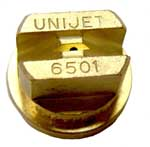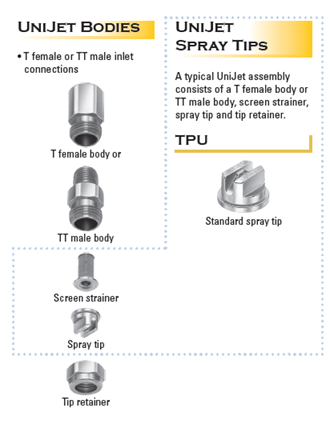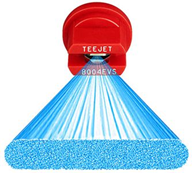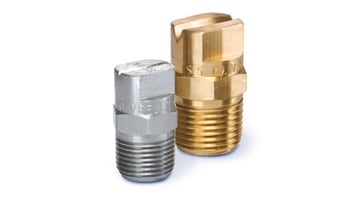VeeJets®, TeeJets®, and FloodJets®, oh my!
Learn about the sizes and types of jets and how this impacts carpet cleaning.
WHY DOES THIS MATTER?
Spray jets are an often overlooked piece of commercial carpet cleaning equipment but they play an important role in the cleaning process. Spray jets affect the amount of water that is put down, the amount of chemical that is used, and the dry times, all of which impact how good your cleaning turns out. A solid understanding of spray jets will enable you to pick the right jet for your cleaning needs.
TYPES OF JETS
There are 3 main types of jets that we use: TeeJets®, VeeJets®, and FloodJets®*. We’ll go over the differences and show you how to identify the different types of jets.
TeeJeT®
The TeeJet® has a flat base and is mounted using a jet body and retaining cap (see diagram below). The jet body can hold a strainer if desired and is threaded into the tool manifold or adapter for installation.

Flat bottom identifies this as a TeeJet since VeeJets have a threaded bottom.
The TeeJet® can be made of brass, stainless steel, or a type of plastic like nylon. A stainless steel jet will last twice as long (or longer) as a brass jet. Nylon jets are commonly found on products that have lower pressure requirements like pump sprayers since the plastic is not as resistant to degradation under high pressures as metal. They can also be used for specialty applications, such as very acidic or basic solutions since these solutions can potentially corrode metal jets.

TeeJet® Diagram. UniJet is a trademark of Spraying Systems Co.
The spray pattern that is almost always used in our industry is called a ‘banded’ pattern. The spray is flat, uniform, and forms a rounded straight line. This makes it easier to aim and spray on the intended surface and avoids overspray on sensitive materials.

Banded spray pattern.
VeeJeT®
For a VeeJet® you should use the same method for identifying spray angle and flow as the TeeJet® (covered below). The difference with a VeeJet® is its construction which uses threads. VeeJets® are mounted by threading the jet into the tool manifold or adapter, whereas the TeeJet® attaches to tools with a retainer cap.

Brass VeeJet® - identified by threaded bottom.
HELP: Why would you use a TeeJet® instead of a VeeJet®? Both can have narrow or wide angle openings, both can put out a small or large volume of water, and both can have strainers... so, what's the difference? Not much. The manufacturer of the jet that it is used on usually has a design where one or the other works better because of size, or how it attaches. One jet works just as well as the other.
FloodJet®
FloodJets® create a wide-angle spray pattern that puts down more solution than VeeJets® or TeeJets®. This is because the jets have a larger orifice, creating larger water droplets. As the water comes out, it strikes the rounded inner surface of the jet and fans out.
Because of the larger orifice and design, FloodJets® are not as prone to clogging as TeeJets and VeeJets. Aside from the visual clues, you can identify a FloodJet® by the markings; (e.g., 1/4K2) The K tells us it’s a FloodJet®, and the ¼” tells us it has ¼” male pipe thread. The 2 represents the orifice size or the flow rate of the jet at 10 PSI. This is different than VeeJets and TeeJets® because their number gives the flow rate at 40 PSI. So, a 2 orifice will flow 0.2 gallons per minute at 10 PSI. There is no spray angle designation on FloodJets®. The width of the spray varies with the water pressure. With higher water pressure, the spray pattern gets wider. This is why you don’t see these used in wands. At a higher PSI, the wand would either have too much overspray or too much water at the edges.

Image of a stainless steel FloodJet®
All jets will wear over time and the size and shape of the orifice will change. As the orifice changes, the spray pattern and flow rate will change. To maintain a proper spray pattern and water usage, jets should be checked, cleaned, and replaced as needed on a regular basis. Brass jets should be replaced every six months and stainless steel jets should be replaced once a year.
NOTE: Spray jets affect the temperature of the cleaning solution. As the orifice size increases and more water is put down, the heater is unable to keep up with the excess water flow and so the water will be colder. Some wands take advantage of this concept by having smaller jets that keep the water hotter. This might require more rinsing strokes to remove all your cleaning solutions, so you should keep this trade-off in mind and use the jet that works best with your heater, solution pump, and vacuum.
If your jet is too large, you'll have cold water, your solution pump won't be able to keep up, and your vacuum might not be strong enough to remove all the water you put down, leading to long dry times. If your dry times are too long, using a jet that puts down less water is a good option.
UNDERSTANDING SPRAY JET PATTERNS
110015
The first two or three numbers tell you the spray angle; the larger the angle, the wider the spray pattern. For the number above, the angle is 110°. The last two or three numbers tell you the orifice size. In this example, the orifice size is 015. The orifice number represents the flow capacity of this jet at 40psi. A 015 orifice will flow 0.15 gallons per minute at 40psi. Your working flow rate will vary with the water pressure.
Let’s go through another example.
8004
What is the spray angle?
The first two or three numbers give you the angle. In the above example, it could be 80° if we used the first two numbers, or 800° if we used the first three. Since there is no such thing as an 800° degree spraying angle, it obviously has to be 80°.
How many gallons per minute will this jet produce?
Remember that these numbers are measured at 40 PSI. As the pressure goes up, more solution will be sprayed out. As the pressure goes down, less solution will come out. Take the last two numbers since we know the angle is 80° which leaves 04 as the number of interest. Always move the decimal one place over to the right and you’ll get the number of gallons per minute that are produced at 40 PSI. So this jet will put out .4 gallons per minute at 40 PSI.
A few more examples:
| Jet Size | Spray Angle | Gallons/Minute @ 40 PSI |
| 6501 | 65° | .1 |
| 65015 | 65° | .15 |
| 95015 | 95° | .15 |
| 11015 | 110° | .15 |
| 9508 | 95° | .8 |
The table below shows how the PSI affects the flow rate. Since no cleaners actually clean at 40 PSI, a rule of thumb to help you with estimates on how much water is put down is to multiply the 40 PSI number by 3.5 to get how much water is put down at 500 PSI.
Using the table below, a cleaner using a 6501 jet, at 500 PSI would put down .1 gallons/min x 3.5 for a total of 0.35 gallons per minute. Compare that to a 9508 jet which puts down .8 gallons/min X 3.5 or 2.8 gallons per minute. That is EIGHT times as much water. A series of 9508 jets on a wand would put down too much water and will seriously slow down dry times.
TEEJET® AND VEEJET® FLOW RATE TABLE
|
Orifice Size |
in inches |
40psi |
60psi |
100psi |
200psi |
300psi |
500psi |
1000psi |
|
0067 |
0.021 |
0.067 |
0.08 |
0.11 |
0.15 |
0.18 |
0.24 |
0.33 |
|
01 |
0.026 |
0.10 |
0.12 |
0.16 |
0.22 |
0.27 |
0.35 |
0.50 |
|
015 |
0.031 |
0.15 |
0.18 |
0.24 |
0.34 |
0.41 |
0.53 |
0.75 |
|
02 |
0.036 |
0.20 |
0.25 |
0.32 |
0.45 |
0.55 |
0.71 |
1.00 |
|
03 |
0.043 |
0.30 |
0.37 |
0.47 |
0.67 |
0.82 |
1.10 |
1.50 |
|
04 |
0.052 |
0.40 |
0.49 |
0.63 |
0.89 |
1.10 |
1.40 |
2.00 |
|
05 |
0.057 |
0.50 |
0.61 |
0.79 |
1.10 |
1.40 |
1.80 |
2.50 |
|
06 |
0.062 |
0.60 |
0.73 |
0.95 |
1.30 |
1.60 |
2.10 |
3.00 |
|
08 |
0.072 |
0.80 |
0.98 |
1.30 |
1.80 |
2.20 |
2.80 |
4.00 |
|
10 |
0.078 |
1.00 |
1.20 |
1.60 |
2.20 |
2.70 |
3.50 |
5.00 |
|
15 |
0.093 |
1.50 |
1.80 |
2.40 |
3.40 |
4.10 |
5.30 |
7.50 |
*VeeJet, TeeJet, and UniJet are trademarks of Spraying Systems Co.
